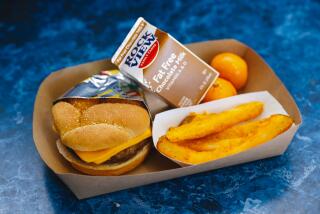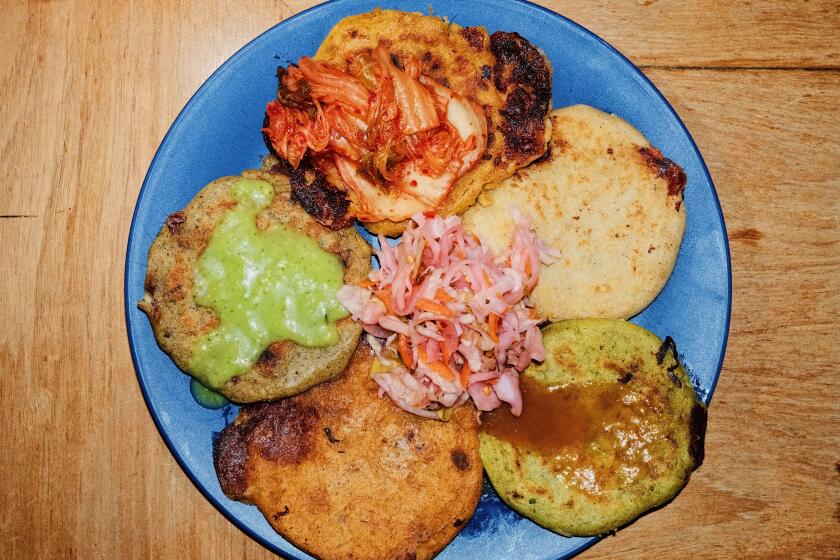Lunch battles: 1 step forward, 1 step back
After the first day of school last Monday, my 7-year-old son, Joey, in between details of his trip to the library and descriptions of his new second-grade classroom, casually imparted the following tidbit about his day: Heâd eaten âmostâ of the lunch I had carefully packed for him, then dipped into his milk-money account for a bag of tortilla chips at the cafeteria. To my shocked look, he said, âWhat? It was only 167 calories.â
Geez, I thought, he actually looked. But my moment of self-congratulation ended quickly. Heâd obviously set aside the perfect, juicy peach I had given him and eaten a bag of salty, fatty, fake-flavored chips instead.
Joeyâs 12-year-old sister, Matilda, did eat her healthy lunch -- partly because it had been planned and negotiated with the same care as her first-day-of-school outfit. A tuna fish sandwich on wheat? Too smelly for the first day -- âIt makes a bad first impression when you open up something that smells weird,â she told me.
So into her designer lunchbox went the flavored water favored by her posse of friends, a lean ham-and-cheese with reduced-fat mayo on wheat bread, a yogurt and a nice peach.
With kids trooping back to school, the airwaves -- and my e-mail in-box -- are full of clever ideas on lunchbox nutrition. The expertsâ tone is upbeat and cheery, but thereâs a subtext of fear and dread: The rise in child obesity will steal your children and rob them of their happy futures. So, Mom and Dad, youâd better rethink those slovenly lunchbox choices and your reliance upon nutritionally suspect school lunches, and get with the program.
As my kids illustrate, itâs not always easy. If theyâre going to eat it -- and not the many junky alternatives available to them -- they have to be on board with a lunchboxâs contents. The experts donât tell you how to find the levers that will encourage them to choose healthy foods. Like so much in parenting, thatâs one of those things you have to learn on the job.
These experts should come to the grocery store with my two kids and me. Theyâd get a lesson both in what they (and we, as parents) are up against. And they might see a ray of hope too.
I took the kids to our well-stocked neighborhood grocery store (not, by the way, a resource that all kids have) and gave each one a basket.
First, I asked each to put into the basket the things he or she would like most to put in a lunchbox. Then I had each kid troll the aisles and choose healthy lunchbox items that he or she would be willing to eat (say, rather than set aside in favor of chips) every day.
The worst fears of the nationâs nutrition experts would be confirmed by my voracious son. Joeyâs nutritional impulses demonstrate clearly what will happen if American children are given free rein to graze, âLord of the Fliesâ-style, on an American landscape rich in salty, sugary, fatty temptations.
He is an indiscriminate eating machine programmed to prefer the highest-calorie victuals he can find, and heâll snarf down anything thatâs not nailed down. He also still takes those TV ads aimed at kids at their word, so if they say that some gummy fructose-laden roll-up is part of an active (read: âhealthyâ) lifestyle, heâll be all over it.
Joey tackled his first challenge with gusto, and it wasnât long before his basket was overflowing with peanut-butter candies; packages of potato chips with text messages imprinted on them and some kind of dipping sauce; cookies in all shapes and sizes; those packages of bright-orange peanut-butter and cheese crackers (his version of a sandwich, I guess); bologna; and a six-pack of neon-colored âsportsâ drinks. He sidled up to the doughnut case and, one by one, pointed to its contents as desirable lunchbox options.
âI would never buy all this stuff,â he says -- a claim I seriously doubt. âItâs got way too much sugar. Iâd weigh 1,000 pounds,â he adds. OK, I think, so I have taught him something. Still, heâs positively giddy with the pleasure of picking it all out.
On the second -- healthy -- round, Joey did just a little better. The bright-orange crackers were still there. The double-chocolate cookies gave way to fig bars, fruit-flavored cereal bars and the reduced-fat versions of some salty snack crackers. But a bunch of bananas had made their way into his basket, and some of those little tubs of cut-up fruit in light syrup. The bologna stayed, but it was turkey bologna.
With his rudimentary reading skills, Joey recognizes the âreduced fatâ label on food packaging and assumes it to mean healthy. If it contains fruit -- or fruit flavoring or even fruit in the name -- it must be good. And -- Iâm ashamed to admit it -- if I have bought it for him before, he assumes itâs probably healthy. Of course, none of these is necessarily true.
Joeyâs 12-year-old sister, Matilda, should give the child-obesity experts hope. Her first -- anything you want -- pass and her second, healthy, trip down the supermarket aisles yielded many of the same choices. Both times, she chose strawberries, fat-free yogurt and vegetable-rich soups labeled as âlower in sodiumâ and âa good source of fiber.â Cans of low-sodium vegetable juice were in both the before and after baskets âbecause my friend Molly says itâs delicious,â said Matilda, pointing out the âHeart Healthy!â label. She thought sheâd like to try pomegranate juice, rich in antioxidants, because her BFF Alex loves it (and itâs in that adorable bottle). She picked out sunflower seeds because her friend Asiaâs dad likes them. Though they have a fair amount of fat, theyâre a good source of protein, she said, turning the jar over to read the label. âAnd these are unsalted,â she noted earnestly.
Like most adults, Matilda tended to be drawn in by the manufacturersâ promotional nutritional seals, such as âbest lifeâ and âheart healthy,â which sometimes donât tell the whole nutritional story.
But she frequently checked labels and seemed to look for evidence of real ingredients, such as vegetables. That said, she didnât spend a lot of time in the produce section itself.
Helping kids like mine to recognize -- and want to eat -- healthy food âis a team effort,â says Pamela Ofstein, the director of nutrition for e-diets.com.
Parents should view packing lunch as a teaching opportunity about which foods are healthy, why and what portions are appropriate, and they should give kids choices and let them help, she adds. That, says Ofstein, is the best way to turn a nutritional wild child like Joey into an adolescent with good instincts about food, and to hone the promising habits of an adolescent like my daughter.
And, she says, letting kids play a role in filling their lunchbox make it more likely theyâll eat the good stuff once theyâre at school.
So, itâs back to the shelves with the cheese crackers, chips and cookies. Bring home the bananas, the low-sugar cereal bars and take two of everything Matilda picked.
Oh, and memo to self: Write the cafeteria lady and tell her the milk-money account is only to be spent on milk!
--
More to Read
Eat your way across L.A.
Get our weekly Tasting Notes newsletter for reviews, news and more.
You may occasionally receive promotional content from the Los Angeles Times.









